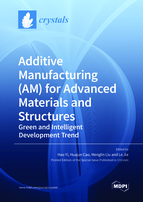Additive Manufacturing (AM) for Advanced Materials and Structures: Green and Intelligent Development Trend
A special issue of Crystals (ISSN 2073-4352). This special issue belongs to the section "Inorganic Crystalline Materials".
Deadline for manuscript submissions: closed (5 November 2022) | Viewed by 39809
Special Issue Editors
Interests: 3D printing and additive manufacturing; micro-droplet printing; wire arc additive manufacturing (WAAM); selective laser melting (SLM); surface engineering; advanced manufacturing; green manufacturing
Special Issues, Collections and Topics in MDPI journals
Interests: advanced manufacturing technology; green manufacturing and equipment; manufacturing system engineering
Special Issues, Collections and Topics in MDPI journals
Interests: 3D printing and additive manufacturing; micro droplet printing; wire arc additive manufacturing (WAAM); advanced manufacturing; green manufacturing
Special Issue Information
Dear Colleagues,
Additive manufacturing (AM) as an advanced manufacturing technology has overturned the traditional concept of subtractive manufacturing. It revolutionizes the integrated advanced design of structural design, high-performance material preparation, and manufacturing of complex components. AM technology is changing the way products are developed, produced, and commercialized, potentiating disruptive changes in economy and society. AM technology has received extensive attention and relentless research from the research community since its inception, and it is leading the frontier of manufacturing technology and continues to surprise us in the aerospace industry, automotive industry, medical plant applications, and many other fields. However, the development of additive manufacturing still faces demanding technical challenges; for example, due to insufficient process planning and inadequate process control, many defects are often observed in the products of AM processes, reducing production efficiency and deteriorating product quality. In order to promote AM technology toward high efficiency, high precision, high performance, and low cost in a green and intelligent direction, many advanced design and manufacturing technologies are in urgent need of further breakthroughs, such as numerical and analytical models for structural design, experimental methods, performance prediction, and process optimization. This urgently requires scholars in the research community to work together in realizing green manufacturing and intelligent manufacturing with additive manufacturing as the core.
Dr. Hao Yi
Prof. Dr. Huajun Cao
Dr. Menglin Liu
Dr. Le Jia
Guest Editors
Manuscript Submission Information
Manuscripts should be submitted online at www.mdpi.com by registering and logging in to this website. Once you are registered, click here to go to the submission form. Manuscripts can be submitted until the deadline. All submissions that pass pre-check are peer-reviewed. Accepted papers will be published continuously in the journal (as soon as accepted) and will be listed together on the special issue website. Research articles, review articles as well as short communications are invited. For planned papers, a title and short abstract (about 100 words) can be sent to the Editorial Office for announcement on this website.
Submitted manuscripts should not have been published previously, nor be under consideration for publication elsewhere (except conference proceedings papers). All manuscripts are thoroughly refereed through a single-blind peer-review process. A guide for authors and other relevant information for submission of manuscripts is available on the Instructions for Authors page. Crystals is an international peer-reviewed open access monthly journal published by MDPI.
Please visit the Instructions for Authors page before submitting a manuscript. The Article Processing Charge (APC) for publication in this open access journal is 2600 CHF (Swiss Francs). Submitted papers should be well formatted and use good English. Authors may use MDPI's English editing service prior to publication or during author revisions.
Keywords
- 3D printing
- additive manufacturing
- advanced manufacturing
- green manufacturing
- intelligent manufacturing
- parts design
- techniques
- materials
- applications
- parts quality
- modelling









